Ahead of this clash between RB Salzburg and SKN St. Pölten the winner already seemed to be clear. St. Pölten are the team with the worst offence among all teams of the Austrian Bundesliga with 14 goals in the first 14 matches. On the other side, the team of Jesse Marsch scored 56 in the opening 14 games. This means that the score on average four goals per 90 minutes.
Besides, St. Pölten has got the second-worst defence of the whole league as they conceded 36 goals in until now. Only Mattersburg has got more goals against them. However, Salzburg sit meanwhile in the first position and are until now unbeaten in the Austrian Bundesliga with 12 wins and two draws. But the most impressing statistic is clearly that Salzburg won 12 out of their 13 matches against St. Pölten in the Austrian Bundesliga – that’s a record in the highest league in Austria.
Considering all these factors it seemed as it would be an easy task for Marsch’s team and besides, they played at home. This tactical analysis will look at both teams’ tactics and how St. Pölten were able to get a 2:2 draw against RB Salzburg
Lineups
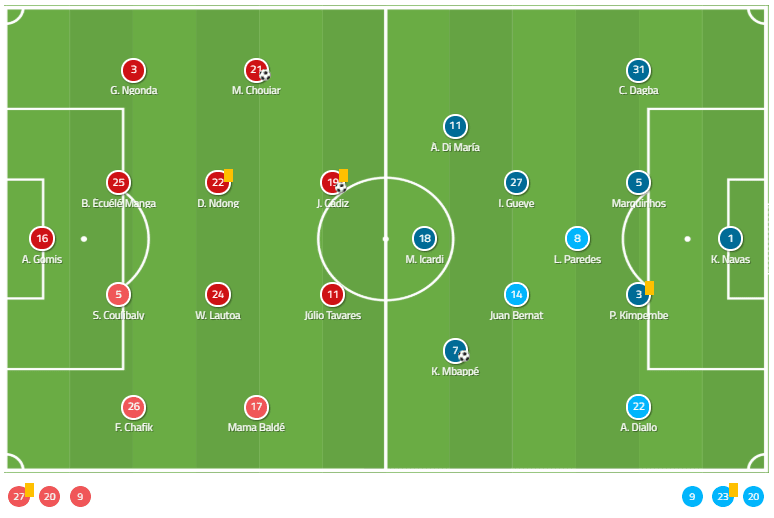
The home team started in a 4-4-2 formation. The goalkeeper was Carlos Coronel since the two first-choice keepers Alexander Walke and Cican Stankovic are currently injured. The back four was made of the captain Andreas Ulmer, Marin Pongračić, André Ramalho and Rasmus Kristensen. The two central midfielders were Zlatko Junuzović and the 19-years-old Mohamed Camara
Masaya Okugawa and Majeed Ashimeru were the wingers while Takumi Minamino and Hee-chan Hwang were upfront. The wingers and the strikers permanently changed their positions to find new and free spaces. The current shooting star of the team Erling Haaland is currently not available due to knee problems.
On the other side, the German coach Alexander Schmidt lined his team up in his typical 5-3-2 formation with Christoph Riegler between the sticks. George Davies and Martin Rasner were the wing-backs. However, after five minutes Rasner got injured and Schmidt brought on Robert Ljubicic for him. Ljubicic was from there on the left wing-back while Davies went on the other side.
The central defence was made of Ahmet Muhamedbegovic, Daniel Drescher and the Brazilian Luan. The three central midfielders were Daniel Luxbacher, Dominik Hofbauer and Michael Ambichl while Kwang-Ryong Pak and Husein Balić played as strikers.
Salzburg’s shape during the build-up and St. Pölten’s response
Salzburg dominated the whole match and had at the end 79% possession and 83% of their passes were successful. During the first half St. Pölten never seemed to get out of their half what their coach Schmidt also noted in other words after the match at the press conference.
“My team was too passive in the first half and I told them in the half time that we should play more active!” – Alexander SchmidtAnyways, Salzburg’s two central midfielders Camara and Junuzović both stayed extremely deep during the build-up. Together with the two centre-backs, they built the passing block. The two full-backs Kristensen and Ulmer positioned themselves during the opening minutes not that wide and helped the four men in the centre. We’ll have a more detailed look at the roles of the full-backs later in this analysis.
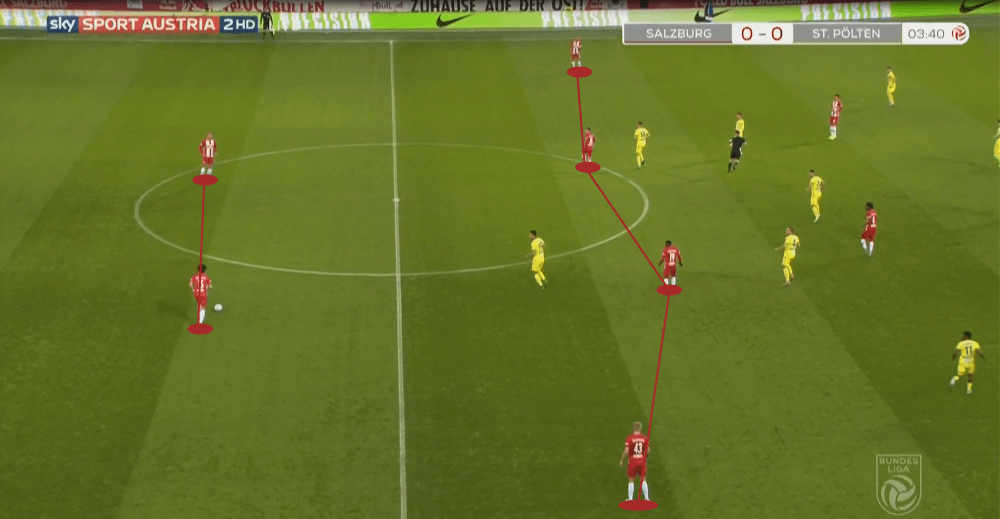
The four other players Ashimeru, Hwang, Minamino and Okugawa all were positioned in the higher lines and moved freely. Ashimeru positioned more on the right-wing and Okugawa on the left one, but they had a lot of freedom. Also, Minamino sometimes dropped deeper to get involved while Hwang mainly stayed between the lines of St. Pölten. However, we also saw situations like in the image below where all four men were positioned in the space between St. Pölten’s back five and their three midfielders.
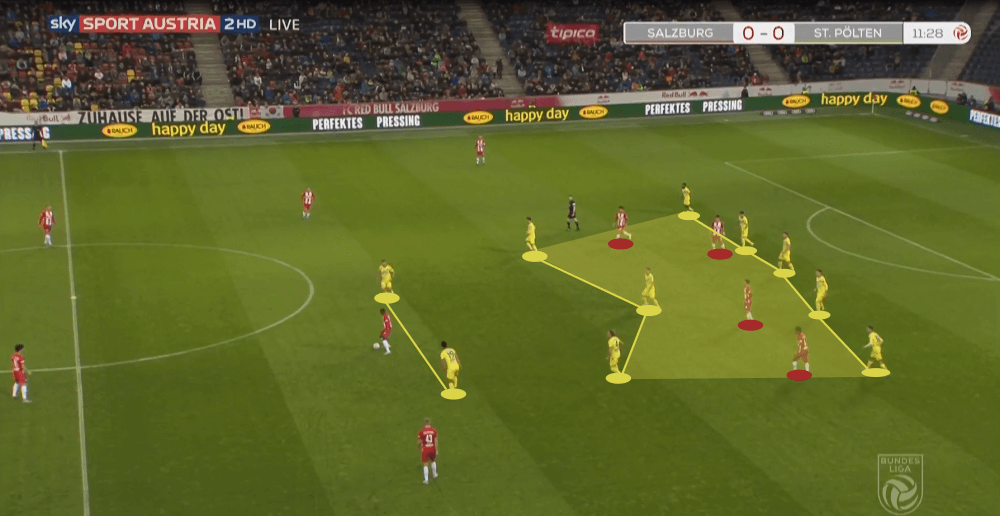
In such situations, the deeper positioned players of Salzburg had a hard time to pick out players in the higher lines since Schmidt’s team was in such a narrow and compact 5-3-2 formation and gave Salzburg almost no room. They defended often extremely deep and didn’t even put pressure on the opponents at the halfway line, but even deeper. In the example below, we can see the two centre-backs Ramalho and Pongračić as the deepest positioned players of Salzburg but notice how high up the pitch they are.
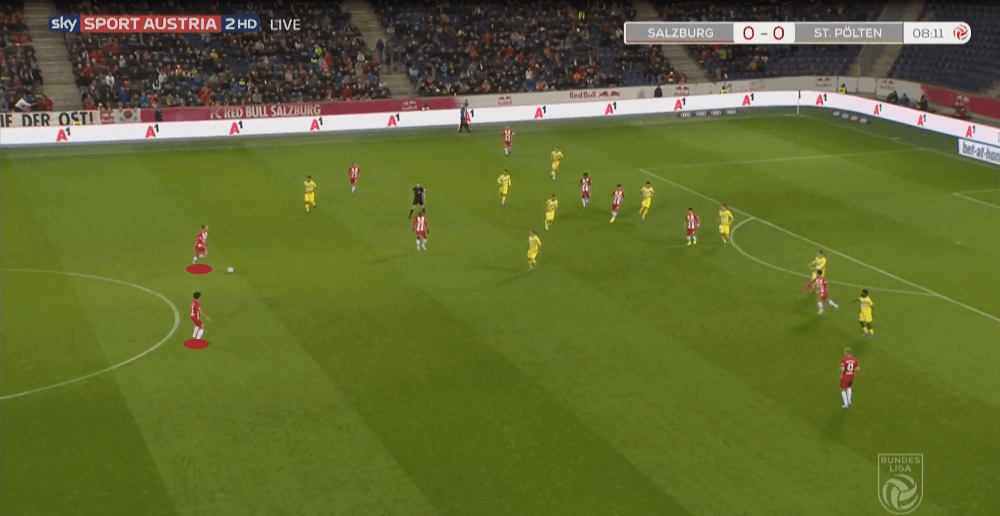
Salzburg’s key to success
The opening minutes showed just what everyone expected: Salzburg dominated the match and St. Pölten sat back and defended with every single man. One of their main goals was to avoid that Salzburg would get into one-on-one situations on the wings since they have skilled and fast players who love such opportunities. Due to that, the central midfielders Hofbauer and Luxbacher always shifted out to the wide areas when the ball was played there to support the wing-backs Ljubicic and Davies. With the aid of that, they were most of the time successful in avoiding one-on-one situations.
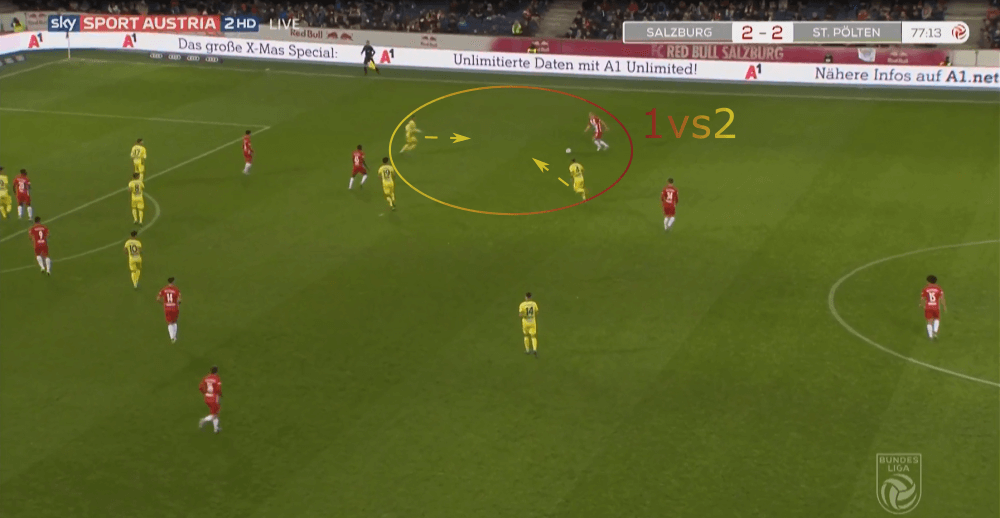
However, ahead of both goals of Salzburg which were scored in the 13th and 34th minute, the team of Marsch was able to bring their players in exactly such one-on-one situations on the wing. Both times, they were able to get past their direct opponent to then create a goalscoring chance which led in both situations to a goal.
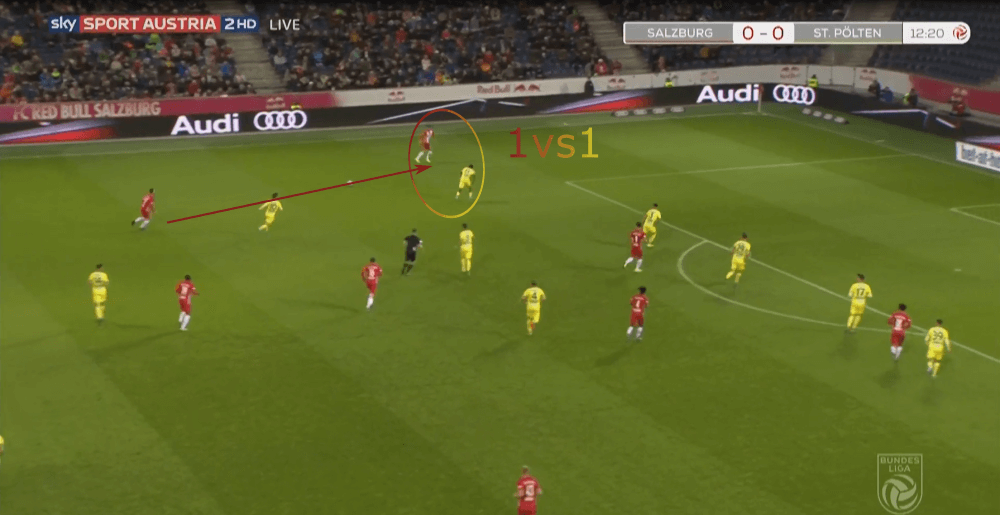
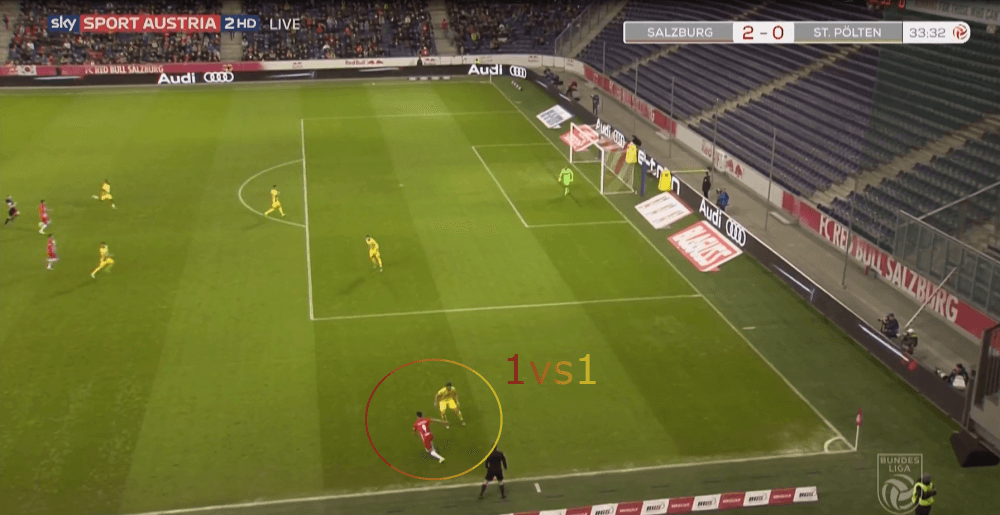
However, you have to give credit to Schmidt’s team as these two situations were one of the very few ones during the 90 minutes. Anyways, the fact that out of two such situations two goals resulted, proves that St. Pölten was right in avoiding exactly that situations. Besides, Schmidt’s squad also were able to rarely allow Salzburg playing through passes behind their last line. Marsch’s team often had to operate with long balls to find a player in the space behind the back four, but these passes were easily defended by St. Pölten.
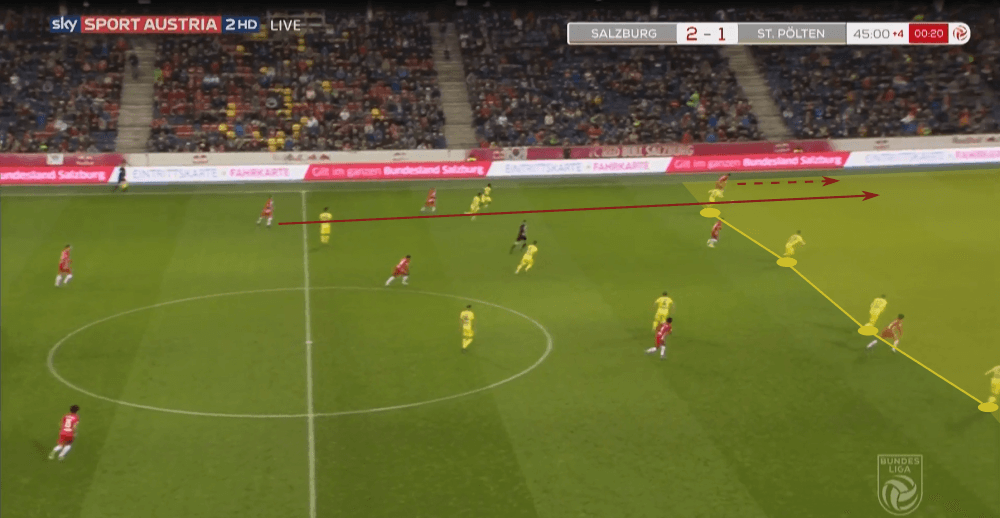
(Counter)pressing to give the opponent no time to breathe
In the first half, St. Pölten was just three times in the penalty box of Salzburg and they just had 19% possession what speaks for itself. This wasn’t just a result of the passivity about which Schmidt talked after the match, but especially the aggressive defending of Salzburg. They are well-known for their pressing and their counter-pressing and they showed both things perfectly in this match.
As soon as one of Salzburg’s players lost the ball, the player of St. Pölten who was then in possession was instantly surrounded by several opponents who tried to win back the ball. This counter-pressing didn’t allow Schmidt’s team to start a counterattack. In the two images below we see two different situations just moments after Salzburg lost the ball and notice in both examples how aggressively they want to immediately win back the ball.
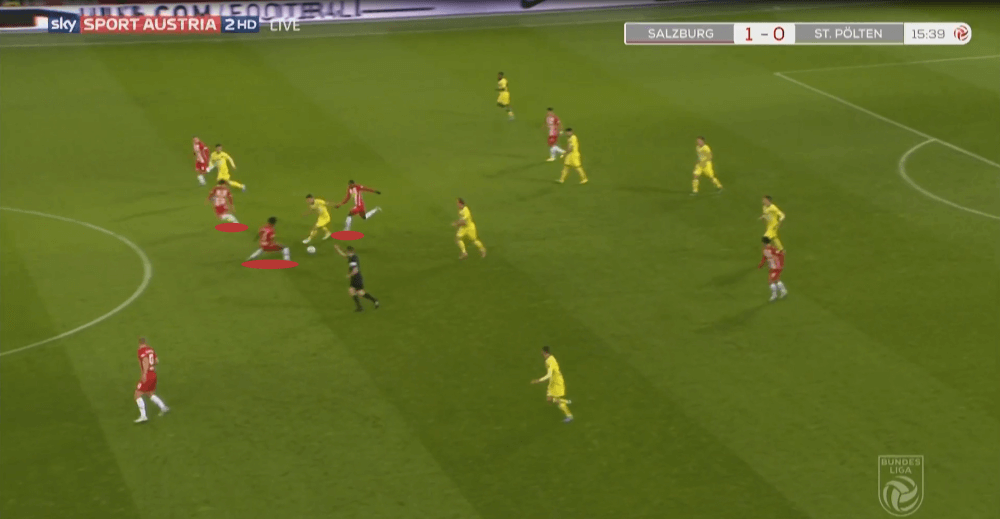
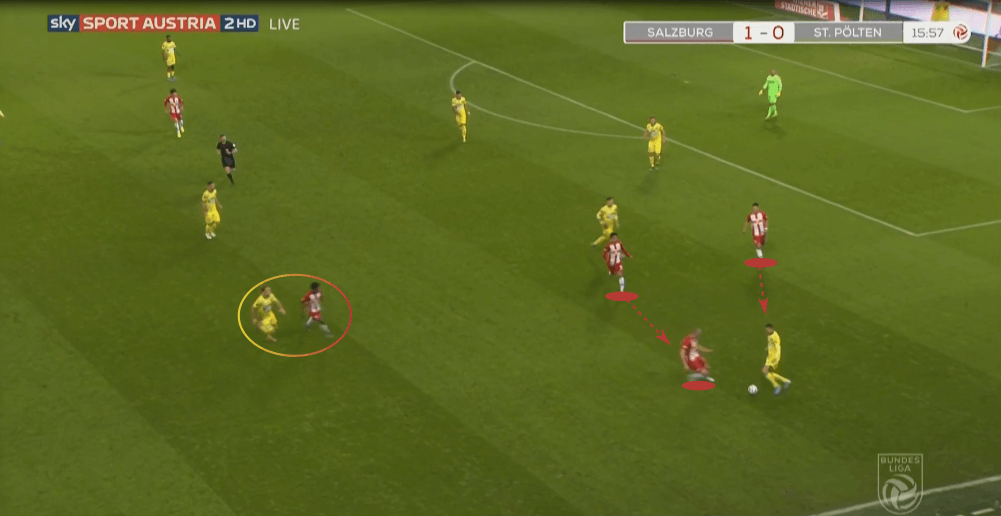
Schmidt’s team mainly operated with long balls. When they had goal kicks, for example, they never played it short, but Riegler always looked for the long ball. However, Ramalho and Pongračić were just incredibly strong in the aerial duels. Besides, the positioning of Salzburg’s players was also good as they won almost every second ball to regain in possession. Considering this, St. Pölten’s main plan for the offence (long balls to Pak or Balić) also didn’t work as Salzburg just seem to win every second ball. So, it is just a logical consequence that Salzburg started attack after attack while Schmidt’s team never seemed to get out of their half.
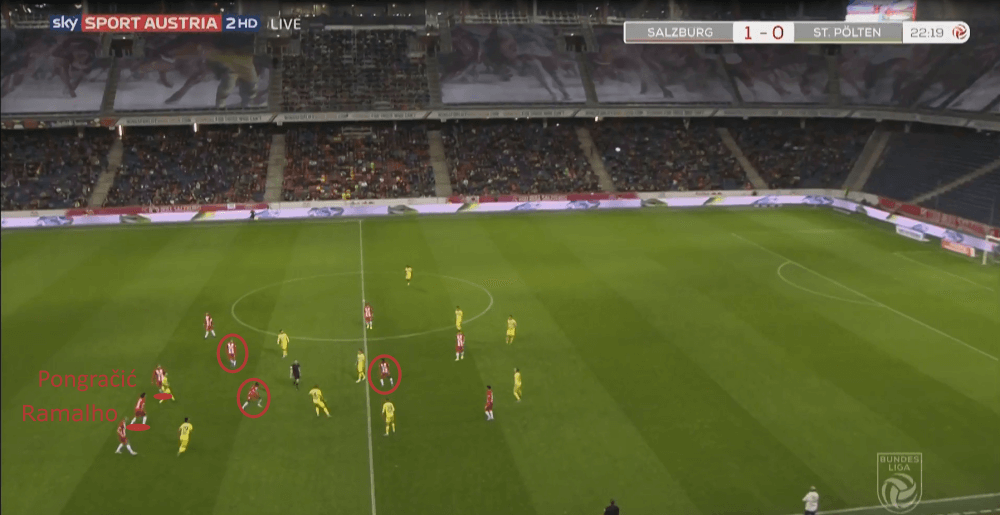
Besides, in the situations in which St. Pölten had the ball in a deeper line, Salzburg used a man-orientated press to give them no chance to play controlled and calm passes. Every passing option for the player in possession was marked and due to that Schmidt’s men often had no other choice, but to play the long ball which then was easily defended by Ramalho and Pongračić.
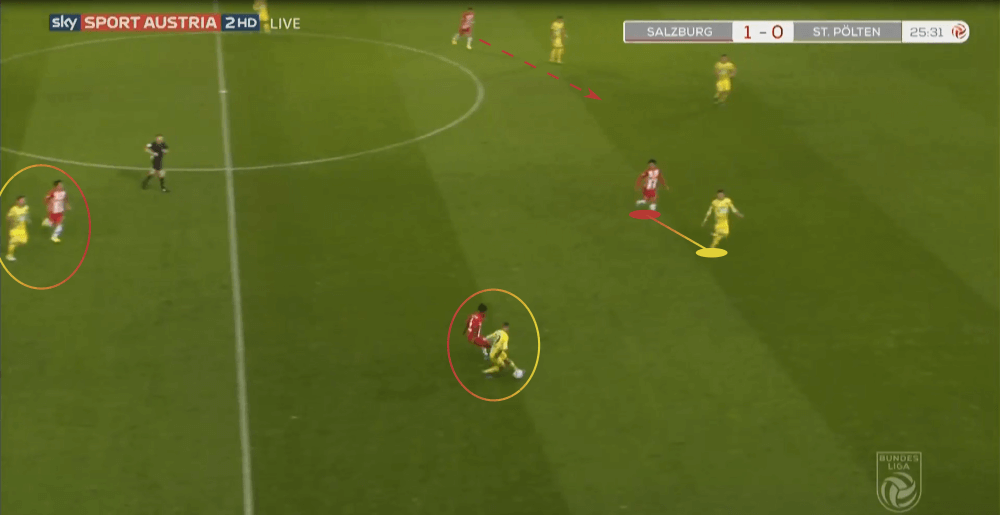
Ulmer and Kristensen
The two full-backs were one of the central players of this match. Not just because Kristensen, for example, had in total 126 times the ball at his feet (highest value of all players), but since the majority of Salzburg’s attack were build-up over the flanks. However, they interpreted their respective roles quite different.
On the left side, we often saw how Ulmer was positioned extremely wide to provide the width and stretch the formation of St. Pölten. Due to that, the passing lane between him and the left centre-back Pongračić would have become too long then, we often saw the central midfielder Junuzović dropping between these two to firstly give the centre-backs another passing option and secondly support the left-back Ulmer. This can be seen in the image below.
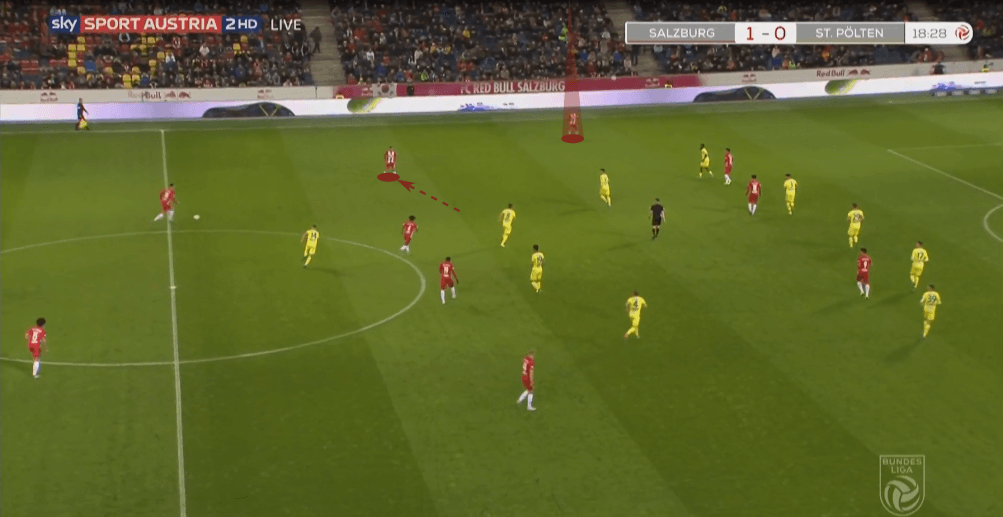
However, in general, Salzburg seemed to be more dangerous on the left side. This was because Junuzović often dropped deeper, he then also moved forward to support Ulmer and Okugawa in the higher lines. On the other side, Kristensen and Ashimeru were often the only two players of Salzburg on the right-wing since Camara stayed deeper and they had due to that a harder task to breakthrough. Besides, Junuzović and Ulmer know each other for a longer time compared to Kristensen and Ashimeru and due to that it seemed at the two Austrians on the left side harmonize way better.
Anyways, Kristensen was often positioned to narrow to stretch the opposition. Due to his positioning, the opposing wing-back Ljubicic also could stay compact and near to his teammates to keep up the compactness. This made it then very hard for Salzburg to breakthrough. Of course, it’s false to say that Kristensen positioning was the only reason that caused Salzburg problems in the offence, but it was one main point.
We can see an example in the image below. The Japanese Minamino plays a great pass to Ramalho to switch the side. However, the right-back Kristensen is positioned way too near to Ramalho. If the Dutchman would position himself closer to the touchline and maybe a bit higher up the pitch, Ramalho could receive the pass of Minamino and then instantly play a ball to the wide-area to Kristensen who would have a lot of space.
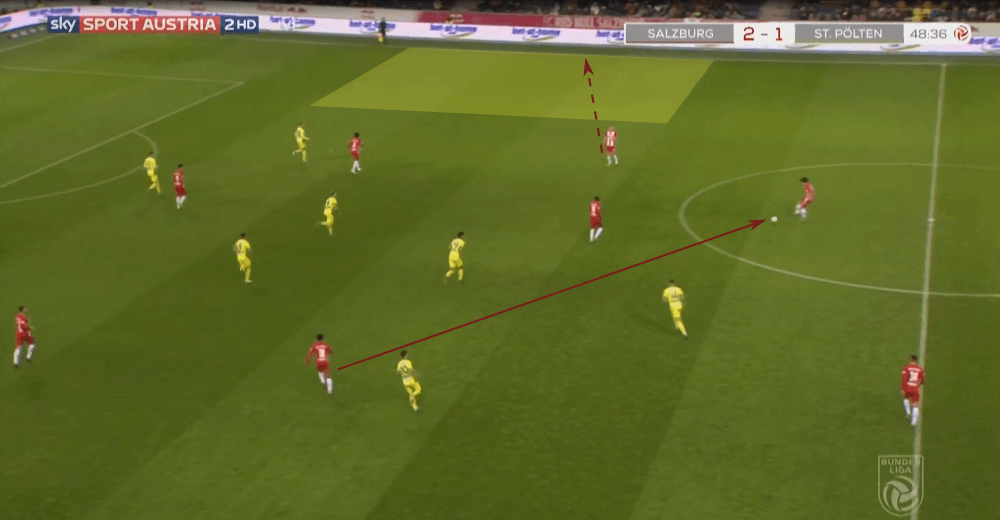
Individual errors cost Salzburg the win
Anyways, as Marsch noted within the last weeks several times and also after this match his team just concedes too many goals at the moment. In this game, it was just the same. Salzburg now conceded 14 goals in the first 15 games in the Bundesliga while LASK Linz who are currently in the second position just got eight goals against them in the same number of games.
However, especially in this game, the goals didn’t happen because of a bad defensive system or since Salzburg defend bad. No, St. Pölten had, besides their two goals, almost no goalscoring opportunities in this game. Ljubicic broke through in one situation in the second half with a dribble and shot past the far hand post, but besides that, Schmidt’s team rarely got dangerous (except the two goals). They were more active and braver in the second half, defended higher and showed great heart, but they seldom seemed to get dangerous. They had in this game 5 shots and while Salzburg shot incredible 19 times.
However, that doesn’t matter at all after the 90 minutes when the result is 2:2. St. Pölten was 2:0 down but came back to get a draw away from home against the league leaders. Now, of course, the question is how they were able to score two goals even though they almost never seemed to get dangerous. The answer is simple: individual errors. The 2:1 was a penalty which resulted out of an unnecessary foul in the penalty box by Pongračić. The 2:2 happened after a terrible mistake by Ramalho of which Pak took advantage. He went down the right-wing, played the ball into the centre where Balić was. Coronel was able to save the first shot just from a few yards, but Balić took the rebound to score the 2:2. In the first image below we can see the foul which led to the penalty while the second shot shows us the mistake of Ramalho ahead of the 2:2.
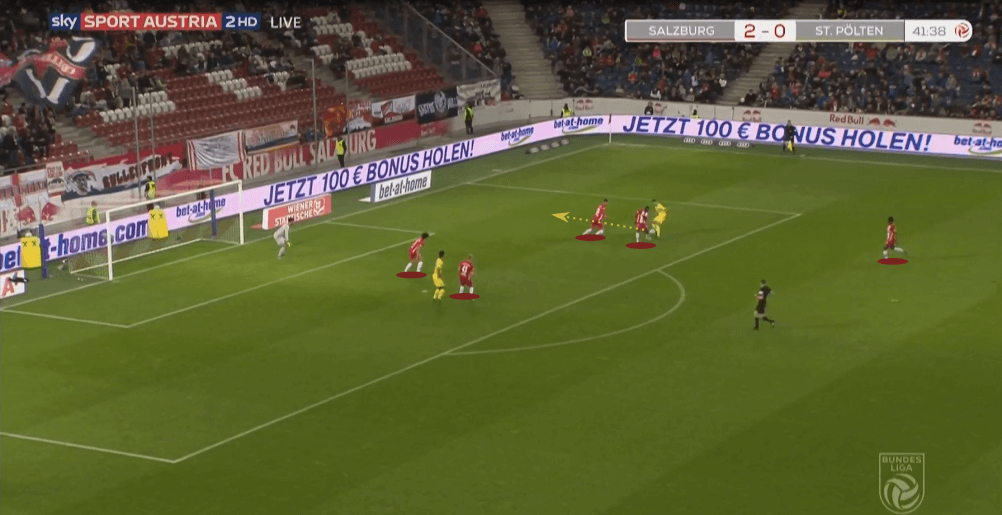
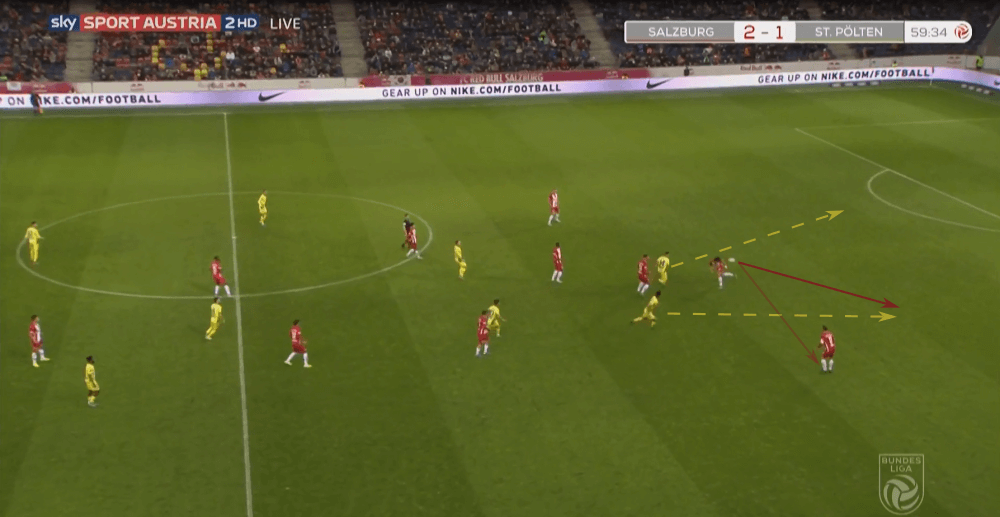
Conclusion
It was a big surprise that St. Pölten was able to get away with the draw, but they defended well and took advantage of the mistakes which Salzburg made. St. Pölten will face Mattersburg next week at home while Salzburg’s next game is the Champions League group stage fixture against KRC Genk away from home. It will be interesting to watch if Marsch’s team can come back on track in this match.

If you love tactical analysis, then you’ll love the digital magazines from totalfootballanalysis.com – a guaranteed 100+ pages of pure tactical analysis covering topics from the Premier League, Serie A, La Liga, Bundesliga and many, many more. Buy your copy of the November issue for just ₤4.99 here





Comments